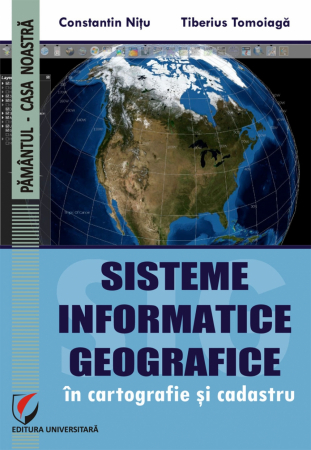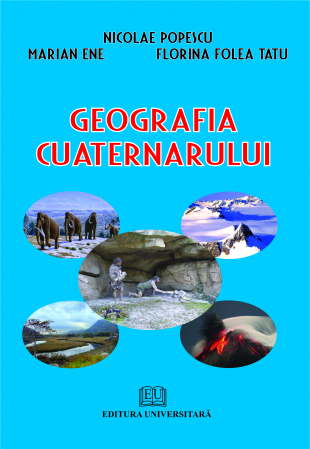ISBN: 978-606-591-162-8
Publisher year: 2011
Edition: I
Pages: 462
Publisher: Editura Universitară
Author: Mihai Ielenicz, Razvan Oprea
- Description
- Authors
- Reviews (0)
Carpathians are great unit that requires a high complexity are creating, leaven, development and reporting all regions of our country. From this multitude of general systems, regional, local landscapes is reflected in as many as were aroused unusual interest and permanent hires an increasing number of large "seekers" of knowledge and explain the meaning of various sides they provide. As a result, the Carpathians were the first space scientific investigation for geographers, geologists, naturalists, sociologists, ethnographers, historians, etc.. to that generated by the natural elements have been twinned with those required by this process and human activities which resulted in a millennial living symbiosis, and defense of a territory statornicirii them together comprise the surrounding hills and plains. They were added to writers, artists, builders, architects, musicians, etc.. who have created outstanding works in accordance with what they received with thought and soul of the gems of these mountains.
Geographers but were and are far more interested in making scientific investigations aimed both deep analysis of environmental elements and components in the overall knowledge of the Carpathians or regional units as well-defined systems. There is some difference in time and space but in orientation domains and direction of reflection in depth approach to understanding and designing of plausible explanations. Since the end of the century. nineteenth-century landscape issues Carpathians study focused most geographers, their attention being directed to understanding their evolution based on tracking surface leveling, presentation glacial relief and issuing of assumptions about the genesis of the contents of gorges and valleys partially Total cross. They were on the one hand a natural response to similar issues raised internationally especially in other European mountain systems (with predilection in Germany, France), and on the other desire unpublished study of the regional situation in the Carpathians. As a result, foreign geographers (Emm. of Martonne, J. Cvijic, L. Sawicki, I. Pawlovski etc.) Were attached to the beginning of sec. twentieth-century geologists and geographers Romans who made the first reference works. Interwar period will be noted on the one hand by increasing the number of works on geography Carpathians between some as doctoral dissertations and articles valuable synthesis (V. Mihailescu, G. Valsan, T. Morariu, M. David, N. The . Radulescu, D. Burileanu, N. Orghidan, N. Popp), some published in prestigious journals or presented at national and international scientific meetings and on the other hand early affirmation of contributions in climatology (monographs of spas) and toponymy ethnography (I. Cone, R. Vuia), settlements etc. hydrology in the analysis. Since 1960 the Carpathian studies will involve all areas of geographic and issue will be not only highly diverse, but both will have three characteristics - depth approach through research and demonstrations, permanent connection between theoretical and practical aspects and a variety of correlations in the system. Many are doctoral theses (for geomorphology, limnology, climatology, hydrology, human and economic geography, geography of tourism, etc..) With reference to geographic units that contain mountain or a part thereof, then lectures, encyclopedias, treatises, a large number of articles published in special volumes or magazines etc. - All requiring a thorough knowledge of the Carpathians, but also a real basis for new investigations designed to meet the vital needs of the beginning of the millennium. Often scientific analysis were added to the wonderful pages of poetry and descriptions for the most picturesque places in the Carpathians made not only writers but also by geography (G. Valsan, I. Simionescu, V. Tufescu etc.).
Writing to volume and those that follow are intended to fulfill several requirements - highlighting important ideas that define the Romanian Carpathian system geographically significant part of larger mountain chain of Europe, which over the years have been highlighted in various works, both as a presentation system Carpathians and geographically distinct but closely related genetic evolution with the surrounding, but also understanding the particular characteristics of the elements defining each component not only in terms of development in time and level of units with variable size but incatenarii of their system, covering systems that give specific geographical landscapes interdependence, steadfastness differentiated between natural environment and human pressures, appreciation proper geographical location of each component in ensuring local and regional potential of the resources included in the determination or restricting capitalization favorabilitatii present in their perspective, and cartographic rendering of some of the significant contributions of various researchers of space mountain.
Extremely high volume of information on his registration imposed Carpathians four distinct volumes. At present we want to create a blueprint for the entire geographic Romanian mountain system as a whole starting from the position of Europe in its formation stages and distinct phases, modeling and reliefs made specific characteristics of the nature of climate, hydrological, biopedogeografica, age and continuing to inhabit the Carpathians as a result of natural factors favorable blending with a specific mental development, recovery time and resource type of complex economic achievement, but regionally differentiated so.
The other volumes are for each unit Carpathian. We want to reflect as well the specific well defined geographically representative units, resulting from the analysis of the contributions they have studied.
In our approach we based both on knowledge of a very rich fund of information I took what was then the representative of its own experience gained over four decades of investigation in most mountain units.
The content-rich information and structuring ideas that they believe has made a significant step in deepening our understanding of these European mountain system, a situation that allows us to recommend it geographically (teachers, students, pupils) and all those with aspirations in deciphering Carpathians mysteries whether they are geologists, biologists, sociologists, ethnographers, historians, etc..
We are confident that tab browsing this volume will lead to wholeness all geographical knowledge rightly called "the stone city of Romanian land" or "Corona muntium" by the role it had in the formation and evolution of millennial our people and the organization and hierarchy media systems in our country.
Prof. dr. Dr. Michael IELENICZ
Prof. PhD, a graduate of Geology-Geography in 1964 where he continued going through all the academic hierarchy. PhD in Geography in 1978 with his "Mountains of Buzau basin - geomorphology study", published in the Academy in 1984.
He won an Academy Award in 1975 for his "relief Romania" and in 1985 for his "Encyclopedia of Romania" and the title of Doctor Honoris Causa of the University Stefan cel Mare - Suceava, he was awarded over 25 honorary degrees, excellent and medals of different educational and scientific institutions home and abroad. Dean and Dean of the Faculty of Geography from 1992 to present, Director of Resort Geographic Orsova, Co-director of "research center and dynamic geomorphological land degradation"
Member of Faculty Council and University Senate since 1992, Chairman of National Committee for the undergraduate education programs (since 1996), member CNATDC, CNEAA, expert CNCSIS, improvements in the country and abroad (UK, Belgium, Turkey), President of the Olympics School of Geography (1996), President of the Society of Geography (2003), Vice President of National Committee of Geography (2000), Vice President of the Association of Geomorphology (2002), PhD (1993), a member of teams The editor of numerous magazines, etc.. He wrote alone and over 210 scientific papers together, participated in 62 research contracts (18 as director), 38 scientific books: "General Geomorphology" 1976, 2002, "Romanian Relief" 1975, "the hills and plateaus of Romania "1999," Physical and Geographical Dictionary "1999," General Geography "2001," Geography and Tourism Romania "2001," Europe Geographical Encyclopedia "2002," Romania Subcarpatii "2003," Romania - Physical Geography "2004," General Physical Geography . Fundamentals of physical geography "2005" Subcarpatii Romania "2005," Geomorphology "2007, 2010," Romania. Physical Geography. Climate, water, vegetation, soils, "2007," Romania. Plateaus and hills "2008," Dictionary of geomorphology "2009," General Physical Geography elements of cosmology "2009," Romania - tourism potential "2009, and numerous popular books, maps etc.

Razvan Oprea Razvan Oprea graduated in Geography, University of Bucharest in 1996, covering all grades of staff to the associate professor in 2009.
Ph.D. in geography in 2004. The thesis was published in 2005 in Bucharest University Publishing House ("mountain basin of Prahova. Study of potential natural and anthropogenic impact on the landscape").
Membership in professional organizations: National Society of Soil Science Romanian, Romania geographical Society, Association of Romania Geomorphology Research Center - land degradation and dynamic geomorphology.
Alone or in collaboration made books ("Dictionary of physical geography," "Physical Geography of Romania. Climate, water, vegetation, soils," "soils in the world", "Compendium of Soil", etc..), Maps, special articles and popular (over 70 published materials), documentation for research contracts and participated in numerous symposia and scientific sessions of the country or abroad (Algeria, Italy, Egypt, France).

6359.png)
![Romania. Carpathians (I - General characteristics) [1] Romania. Carpathians (I - General characteristics) [1]](https://gomagcdn.ro/domains/editurauniversitara.ro/files/product/large/romania-carpatii-i-caracteristici-generale-2055-711701.jpg)













